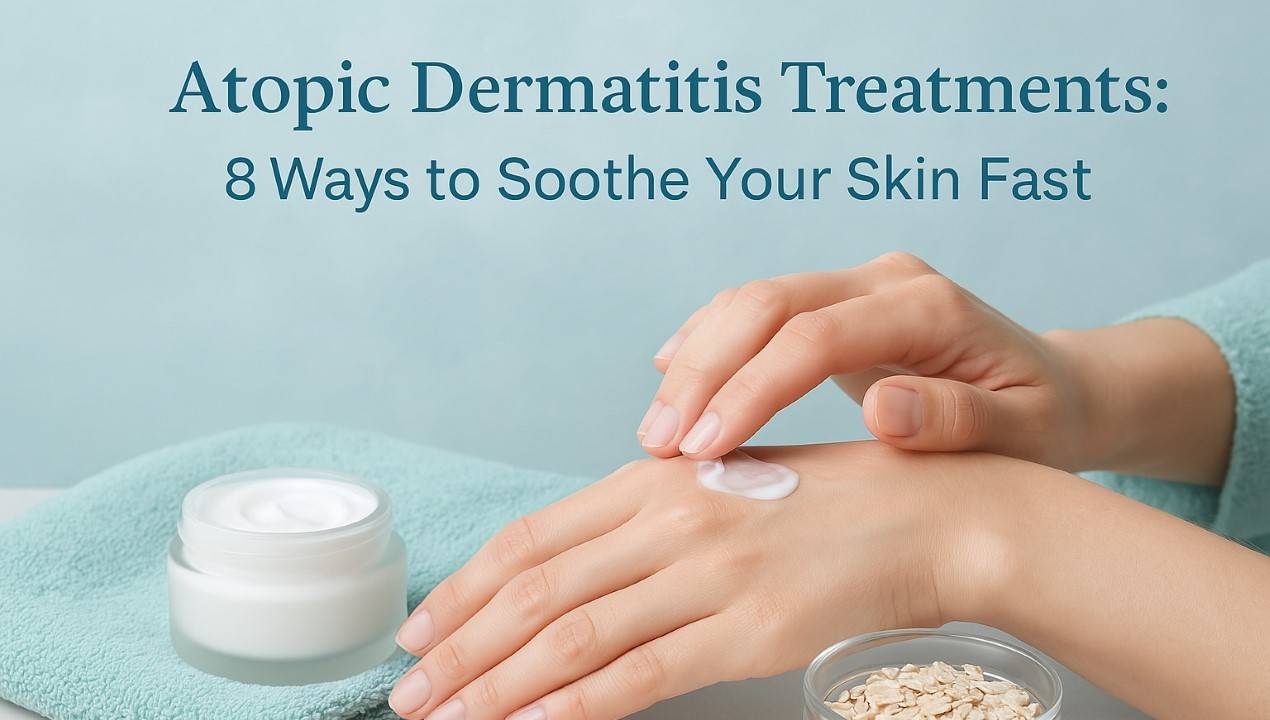Atopic dermatitis treatments help calm itchy, red, and dry skin caused by eczema. This skin condition makes your skin feel uncomfortable. It can appear as red patches or bumps. The good news? You can soothe your skin with simple steps. From moisturizing to avoiding triggers, these eight tips will help you feel better fast.
Understanding Atopic Dermatitis
Eczema—also called atopic dermatitis—is a frequent skin issue. It makes your skin red, itchy, and dry. It often starts in kids, but can affect adults, too. I’ve seen many people struggle with itchy skin remedies because eczema can flare up suddenly. It’s not contagious, so you don’t catch it from others.
What Causes Eczema?
Eczema happens when your skin barrier doesn’t work well. This lets moisture escape and irritants enter. Things like stress, allergies, or weather can trigger it. I like learning about triggers because it helps me prevent eczema flare-ups. Common causes include:
- Dry air
- Harsh soaps
- Food allergies
- Stress
Knowing your triggers is a big part of atopic dermatitis treatments.
Why Atopic Dermatitis Treatments Matter
Eczema can make life hard. Itchy skin keeps you awake. Red patches can make you feel shy. I’ve seen how eczema relief changes lives. Treatments stop itching, heal skin, and prevent flare-ups. They help you feel comfortable in your skin again. Let’s explore eight Eczema treatment options to soothe your skin fast.
1. Moisturize Your Skin Every Day
Dry skin makes eczema worse. Moisturizers for eczema are my favorite because they work so well. Rich creams and balms lock in moisture to soften your skin. I’ve tested unscented creams, and they’re gentle on my skin. Choose skincare with ceramides or hyaluronic acid for deep hydration.
How to Moisturize Right
- Apply cream after a bath or shower.
- Use it twice a day.
- Choose fragrance-free products.
Moisturizing is a top atopic dermatitis treatment. It’s like hugging your skin!
2. Take Short, Lukewarm Showers
Hot water dries your skin. Long showers strip away natural oils. I’ve noticed skin inflammation treatment starts with better bathing habits. Short, lukewarm showers keep your skin happy.
Shower Tips for Eczema
- Keep showers under 10 minutes.
- Use mild, scent-free soap.
- Pat your skin dry, don’t rub.
This simple atopic dermatitis treatment prevents flare-ups.
3. Use Topical Steroids for Flare-Ups
When itching gets bad, topical corticosteroids for eczema help fast. These creams reduce redness and swelling. I’ve seen over-the-counter hydrocortisone work for mild cases. For stronger options, ask your doctor.
How to Use Steroids Safely
- Apply a thin layer on red spots.
- Use for a short time.
- Follow your doctor’s advice.
Topical steroids for flare-ups are a key atopic dermatitis treatment. Always check with a doctor first.
4. Try Natural Remedies for Gentle Care
I love natural remedies for atopic dermatitis because they’re gentle. They’re great for sensitive skin. Two options I’ve tried are:
- Coconut oil: It soothes dry skin. Apply after a shower.
- Oatmeal baths: Add colloidal oatmeal to bathwater. Soak for 15 minutes.
These atopic dermatitis treatments calm itching naturally. Patch test a tiny spot to rule out skin reactions.
5. Avoid Your Eczema Triggers
Triggers make eczema worse. I’ve seen how allergy triggers and eczema flare-ups go hand in hand. Common triggers include soaps, stress, or certain foods like dairy. Avoiding them is a smart atopic dermatitis treatment.
How to Spot Triggers
- Keep a diary of flare-ups.
- Use hypoallergenic detergent.
- Relax with deep breathing.
Eczema flare-up prevention keeps your skin calm.
6. Wear Soft, Breathable Clothes
Rough fabrics like wool irritate the skin. I’ve noticed hypoallergenic skincare routines include clothing choices. Cotton clothes are my go-to because they’re soft.
Clothing Tips for Eczema
- Choose loose, cotton outfits.
- Avoid wool or polyester.
- Wash new clothes before wearing them.
This atopic dermatitis treatment reduces itching.
7. Use Antihistamines for Itchy Nights
Itching can ruin sleep. Itch relief for atopic dermatitis is a significant change. Antihistamines like Benadryl reduce itching and help you rest. They worked well for me.
How to Use Antihistamines
- Take care at night to avoid drowsiness.
- Follow the package directions.
- Ask a doctor if you are unsure.
This atopic dermatitis treatment helps you sleep better.
8. Explore Advanced Treatments with a Doctor
For severe eczema, you may need stronger atopic dermatitis treatments. I’ve seen biology for eczema management help friends with tough cases. Options include:
- Phototherapy: Uses light to calm skin.
- Biologics: Injections like dupilumab target inflammation.
- JAK inhibitors: Pills that reduce swelling.
When to See a Doctor
- If the skin is painful or infected.
- If flare-ups won’t stop.
- For a custom treatment plan.
Prescription eczema care can renew and calm your skin.
Building a Daily Eczema Care Routine
A routine makes atopic dermatitis treatments work better. This works for me—it’s clear and easy to stick to.
- Morning: Shower with lukewarm water. Moisture.
- Daytime: Reapply cream. Avoid triggers.
- Evening: Use steroids if needed. Take an antihistamine.
- Weekly: Try an oatmeal bath.
This keeps your skin calm.
Lifestyle Tips for Better Skin
Your lifestyle affects eczema. I’ve seen eczema management strategies work wonders. Try these:
- Reduce stress: Yoga or meditation helps.
- Eat well: Fruits and fish with omega-3s are great.
- Drink water: It keeps skin hydrated.
These support your atopic dermatitis treatments.
FAQs About Atopic Dermatitis Treatments
What’s the most effective way to treat atopic dermatitis?
The best atopic dermatitis treatment depends on you. For mild cases, moisturizers for dry skin relief and steroids work well. For severe eczema, biologics for eczema management or phototherapy for eczema treatment may help. I’ve seen that moisturizing daily makes a big difference for most people. Ask your doctor for a plan that fits you.
Does Atopic Dermatitis Go Away?
Eczema doesn’t always go away. Some kids outgrow it, but adults can have it too. Chronic skin condition treatments like moisturizing and avoiding triggers help control it. I’ve noticed consistent care keeps my skin calm for months.
What Can Trigger Atopic Dermatitis?
Triggers vary. Common ones are stress, harsh soaps, or foods like eggs. Allergy triggers and eczema flare-ups are linked. I keep a diary to track my triggers, and it helps me avoid dermatitis flare-ups.
Dos and Don’ts in Atopic Dermatitis?
Do’s:
– Moisturize daily.
– Use gentle soaps.
– Wear soft clothes.
Don’t:
– Don’t use hot water.
– Don’t scratch your skin.
– Don’t ignore triggers.
These tips make atopic dermatitis treatments more effective.
Final Thoughts on Atopic Dermatitis Treatments
Eczema can be tough, but Eczema relief options make it manageable. I’ve seen these eight tips help people feel better fast. Start with moisturizing and gentle showers. Try natural eczema cures like coconut oil. Consult your doctor on eczema meds if symptoms persist.
You about kin deserve care, so start today! Have a favorite eczema relief option? Share it below!
Recommended Reading



